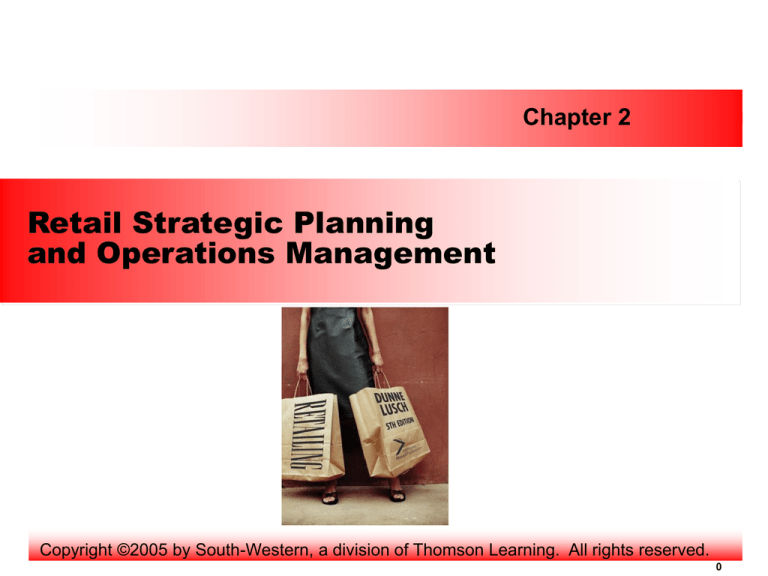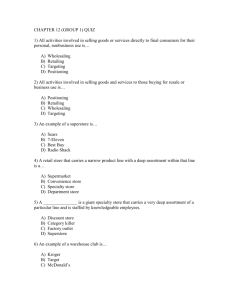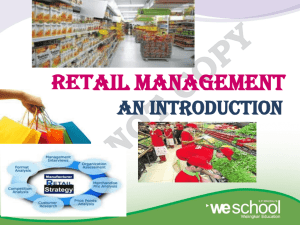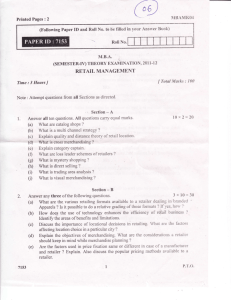
Chapter 2
Retail Strategic Planning
and Operations Management
Copyright ©2005 by South-Western, a division of Thomson Learning. All rights reserved.
0
Learning Objectives
• Explain why strategic planning is so important and be
able to describe the components of strategic planning:
statement of mission; goals and objectives; an
analysis of strengths, weaknesses, opportunities, and
threats; and strategy.
• Describe the text’s retail strategic planning and
operation management model, which explains the two
tasks that a retailer must perform and how they lead to
high profit.
1
Components of Strategic Planning
LO 1
Planning
Is the anticipation and organization of what needs to
be done to reach on objective.
2
Components of Strategic Planning
LO 1
Strategic Planning
Involves adapting the resources of the firm to the
opportunities and threats of an ever changing retail
environment.
3
Components of Strategic Planning
LO 1
•
•
•
•
Mission Statement
Statement of Goals and Objectives
Strategies
SWOT Analysis
4
Components of Strategic Planning
LO 1
Mission Statement
is a basic description of the fundamental nature,
rationale, and direction of the firm.
5
Elements of a Mission Statement
LO 1
• How the retailer uses or intends to use its
resources
• How it expects to relate to the ever-changing
environment
• The kinds of values it intends to provide in order
to serve the needs and wants of the consumer
6
Components of Strategic Planning
LO 1
Goals and Objectives
Are the performance results intended to be brought
about through the execution of a strategy.
7
Statement of Goals and Objectives
LO 1
•
•
•
•
Market Performance Objective
Financial Performance Objective
Societal Objectives
Personal Objectives
8
Statement of Goals and Objectives
LO 1
Market Performance Objectives
represents how a retailer desires to be compared to its
competitors.
9
Importance of Planning - Sam’s View
LO 1
Sam M. Walton
Chairman and Chief Executive Officer
May 4, 1998
Dear Bob:
I am replying to your letter of the 19th concerning the Wal-Mart monopoly of
communities. I have realized for some time and, I suspect, many folks have in the
company, as well, how fortunate we are to have very little competition in some of the
larger communities in the country. That hasn’t always been the case, as you well know.
The history of our company has been that we have had more competition early on than
most any regional discounter in the United States. However, one by one, our
competitors weakened, were mis-managed, and have fallen out in many of the cities that
we practically no have to ourselves. That has been the case generally with Howard’s,
TG&Y, Gibson, Kuhn’s, Magic Mart, and certainly some of the variety chains which were
once active in this area. These competitors, plus Alco, Pamida, and the group in
Indiana, are on the ropes now and I don’t choose to believe those companies
disappeared because of our effectiveness. Rather, I choose to believe, for the most part,
they were mis-managed and, had they been managed well, there could and would have
been enough business in their areas for them and for us….
10
Market Performance Objectives
LO 1
• Sales Volume
• Market Share
Is the retailer’s total sales divided by total market
sales.
11
Statement of Goals and Objectives
LO 1
Financial Performance Objectives
Represent the profit and economic performance a
retailer desires.
12
Financial Performance Objectives: Profitability
LO 1
•
•
•
•
•
Net Profit Margin
Asset Turnover
Return on Assets
Financial Leverage
Return on Net Worth
13
Financial Performance Objectives: Profitability
LO 1
• Net Profit Margin
Is the ratio of net profit (after taxes) to total sales and
shows how much profit a retailer makes on each dollar
of sales after all expenses and taxes have been met.
14
Financial Performance Objectives: Profitability
LO 1
• Asset Turnover
Is the total assets and shows how many dollars of
sales a retailer can generate on an annual basis with
each dollar invested in assests.
15
Financial Performance Objectives: Profitability
LO 1
• Return on Assets (ROA)
Is net profit (after taxes) divided by total assets.
16
Financial Performance Objectives: Profitability
LO 1
• Financial Leverage
Is total assets divided by net worth or owners’ equity
and shows how aggressive the retailer is in its use of
debt.
17
Financial Performance Objectives: Profitability
LO 1
• Return on Net Worth (RONW)
Is net profit (after taxes) divided by owners’ equity.
18
Strategic Profit Model
LO 1: Exhibit 2.1
Net Profit
Margin
Net Profit*
Total Sales
x
Asset
Turnover
=
Return on
Assets
Net Profit*
Total Assets
x
Financial
Leverage
Total Assets
Net Worth
=
Return on
Net Worth
Net Profit*
Net Worth
Total Sales
Total Assets
*Net profit after taxes
19
Financial Performance Objectives: Productivity
LO 1
• Productivity Objectives:
State the sales objective that the retailer desires for
each unit of resource input: floor space, labor, and
inventory investment.
20
Financial Performance Objectives: Productivity
LO 1
• Space Productivity
Annual net sales divided by the total square feet of
retail floor space.
21
Financial Performance Objectives: Productivity
LO 1
• Labor Productivity
Annual net sales divided by the number of full-timeequivalent employees.
22
Financial Performance Objectives: Productivity
LO 1
• Merchandise Productivity
Annual net sales divided by the average dollar
investment in inventory.
23
Statement of Goals and Objectives
LO 1
Societal Objectives
Reflects the retailer’s desire to help society fulfill some
of its needs.
• Employment objectives
• Payment of taxes
• Consumer choice
• Equity
• Benefactor
24
Statement of Goals and Objectives
LO 1
Personal Objectives
Reflects the retailer’s desire to help individuals
employed in retails fulfill some of their needs.
• Self-gratification
• Status and respect
• Power and authority
25
Retail Objectives
LO 1: Exhibit 2.2
Sales
Volume
Market
Share
SelfGratification
Profitability
Market
Performance
Objectives
Financial
Performance
Objectives
Retail
Mission
Personal
Objectives
Societal
Objectives
Productivity
Employment
Taxes
Power and
Authority
Consumer
Choice
Status and
Respect
Equity
Benefactor
26
Strategies
LO 1
Strategy
Is a carefully designed plan for achieving the retailer’s
goals and objectives.
27
Minimal Retail Strategies
LO 1
Get shoppers into your store.
Convert these consumers into customers
by having them purchase merchandise.
Do this at the lowest operating cost
possible that is consistent with the
level of service that your customers expect.
28
Question to Ponder
• How should a retailer determine the proportion and
the number of market performance, financial
performance, societal, and personal objectives?
29
Strategies
LO 1
SWOT Analysis
Is the identification and analysis of a retailer’s
strengths, weaknesses, opportunities and threats a
firm faces.
30
SWOT Analysis: Outback Restaurant
LO 1
Strengths?
Weaknesses?
Opportunities?
Threats?
31
Strategies
LO 1
Target Market
Is the group or groups of customers that the retailer is
seeking to serve.
32
Strategies
LO 1
Location
Is the geographic space or cyberspace where the
retailer conducts business.
33
Strategies
LO 1
Retail mix
Is the combination of merchandise, assortment, price,
promotion, customer service, and store layout that
best serves the segments targeted by the retailer.
34
Service Retailing
Even though many flyers
tried JetBlue for the first
time because of its low
fares, the airline’s
customer service won
them over.
35
Retail Planning and Management
LO 2
• Strategic Planning
• Operations Management
• Administration
• High-Profit Retailing
36
Retail Planning and Management
LO 2
Strategic Planning
Is a plan of action detailing how the retailer will
respond to the environment in an effort to establish a
long-term course of action to follow.
37
Retail Strategic Planning and Operations Management
Model
LO 2: Exhibit 2.4
Competitive Environment:
Behavior of Consumers, Competition and Channel Members
Strategic Planning
SWOT
Mission
Goals and
Objectives
Strengths
Weaknesses
Opportunities
Threats
Social and Legal Environment:
Socioeconomic Environment, State of Technology, Legal System, Ethical Behavior
38
Retail Strategic Planning and Operations Management
Model
LO 2: Exhibit 2.4
Competitive Environment:
Behavior of Consumers, Competition and Channel Members
Retail Marketing
Strategy
Target Market(s)
Location(s)
Retail Mix
Merchandise Pricing
Advertising &
Promotion
Customer Service &
Selling
Store Layout &
Design
Operations
Management
Buying & Handling
Merchandise
Pricing
Advertising &
Promotion
Customer Services
& Selling
Facilities
High-Profit
Performance
Retailing
Social and Legal Environment:
Socioeconomic Environment, State of Technology, Legal System, Ethical Behavior
39
Retailing Truism
LO 2
Good execution can never overcome bad planning.
40
Retail Planning and Management
LO 2
Operations Management
Deals with activities directed at maximizing the
efficiency of the retailer’s use of resources. It is
frequently referred to as day-to-day planning.
41
Retail Planning and Management
LO 2
Administration
Involves the acquisition, maintenance, and control of
resources that are necessary to carry out the retailer’s
strategy.
42
Retail Planning and Management
LO 2
High-Profit Retailing
To be a high profit retailer, the retailer needs good
strategic planning coupled with strong operations
management.
43
Square Feet of Retail Space
LO 2
Football Field
54,000 sq ft.
120 yards
360 ft.
Supercenters
80,000 - 100,000 sq ft.
Example: 108,000 sq ft.
End Zone
End Zone
End Zone
50
50
50
End Zone
End Zone
End Zone
50 yards
150 ft.
44
The SPM for Some of the Country’s Top Retailers
LO 2: Exhibit 2.5
45
Additional Slides
46
Elements of a Mission Statement
LO 1
the kinds of vales
it intends to offer to serve
the needs and wants of
the consumers
how it expects to
relate to the
ever-changing
environment
how the retailer
uses or intends
to use its
resources
47
Goals and Objectives
LO 1
Market
Performance
Objectives
Societal
Objectives
Financial
Performance
Objectives
Personal
Objectives
48
Retail Planning and Management
LO 2
Strategic
Planning Administration
Operations HighManagement Profit
Retailing
49








